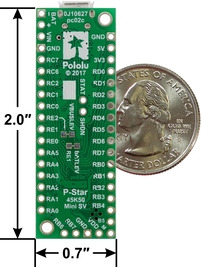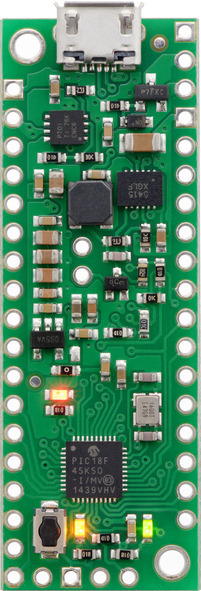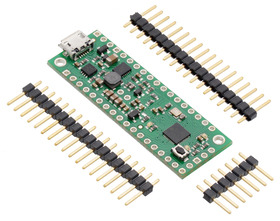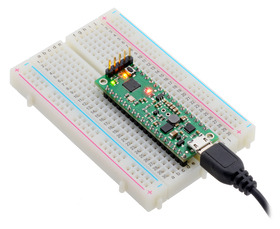
P-Star 45K50 Mini SV
Tutti i prezzi sono IVA inclusa
The P-Star 45K50 Mini SV is a small programmable module featuring Microchip’s PIC18F45K50 microcontroller. It packs a Micro-USB interface and 30 digital input/output pins onto a board measuring 2″ × 0.7″ and ships preloaded with a USB bootloader, so no external programmer is required.
 |
P-Star 45K50 Mini SV dimensions, with U.S. quarter for size reference. |
|---|
Overview
The Pololu P-Star 45K50 Mini SV is a general-purpose programmable module based on Microchip’s PIC18F45K50 microcontroller, which has 32 KB of flash program memory, 2 KB of RAM, and built-in USB functionality. On-board features of the P-Star (abbreviated P*) include a 16 MHz crystal, a USB Micro-B connector, and three user-controllable indicator LEDs. A switching step-down voltage regulator and power selection circuit allow the board to be powered from either USB or an external 5 V to 36 V source, while a current limit on the USB VBUS supply and reverse protection on VIN help protect it from accidental damage. The board ships with a USB bootloader that makes it easy to program the PIC microcontroller without using an external programmer.
Our comprehensive user’s guide provides the basics you need to get started with the P-Star as well as detailed technical information.
This product requires a USB A to Micro-B cable (not included) to connect to a computer.
 |
P-Star 45K50 Mini SV, top view. |
|---|
Features
- Dimensions: 2″ × 0.7″ (2.05″ × 0.7″ including USB Micro-B connector)
- Programmable Microchip PIC18F45K50 microcontroller
- 32 KB flash (8 KB used by bootloader, leaving 24 KB available for user program by default)
- 2 KB SRAM
- 256 bytes of EEPROM
- Native full-speed USB (12 Mbps)
- Internally clocked at 48 MHz, resulting in execution speeds up to 12 million instructions per second (MIPS)
- Precision 16 MHz crystal
- 30 I/O lines in a small package
- 28 user I/O pins on the two long sides of the board
- 2 additional I/O pins available in other locations
- 25 pins can be configured as analog inputs
- 2 PWM output signals (one of which can be sent to four different pins)
- 5-bit digital-to-analog converter (DAC) output
- Three user-controllable LEDs
- Reset button
- USB Micro-B connector
- Can be powered from USB or external source regulated to 5 V by onboard regulator
- Operating voltage: 5 V to 36 V
- 5 V logic voltage
- Auxiliary 3.3 V linear regulator
- Reverse-voltage protection on external power input
- Ships with a proprietary USB bootloader developed by Pololu for the P-Star
- Bootloader is usable from Windows, Linux, and Mac OS X with open source software
- No external programmer required
- Compatible with standard Microchip compilers, development tools, and programmers
- Comprehensive user’s guide
Pinout
 |
P-Star 45K50 Mini SV pinout diagram. |
|---|
This diagram identifies the I/O and power pins on the P-Star 45K50 Mini SV. The diagram is also available as a printable PDF (547k pdf). For more information about the PIC18F45K50 microcontroller and its peripherals, see Microchip’s PIC18F45K50 documentation.
Included hardware
Two 1×18-pin breakaway 0.1″ male headers and one 1×7-pin breakaway 0.1″ male header are included with the P-Star 45K50 Mini. These header pins can be soldered in to use the board with perfboards, breadboards, or 0.1″ female connectors.
|
|
The P-Star family
The P-Star 45K50 Mini is part of our P-Star family. The table below lists the members of the family and shows the key differences between them.
 |
P-Star 25K50 Micro (top) and P-Star 45K50 Mini SV (bottom). |
|---|
 |
 |
|
| P-Star 25K50 Micro | P-Star 45K50 Mini SV | |
|---|---|---|
| Microcontroller: | PIC18F25K50 | PIC18F45K50 |
| User I/O lines: | 19 | 30 |
| Analog inputs: | 14 | 25 |
| Reset button: |  |
|
| Operating voltage: | 5.5 V to 15 V | 5 V to 36 V |
| Regulator type: | linear | switching step-down |
| Regulated current:(1) | 100 mA | 500 mA |
| Auxiliary 3.3 V regulator: |  |
|
| Dimensions: | 1″ × 0.6″ | 2.0″ × 0.7″ |
| Weight:(2) | 1.3 g | 3.5 g |
1 These values are rough approximations for comparison purposes. Available current depends on input voltage, current consumed by the board, ambient conditions, and regulator topology.
2 Without included optional headers.









